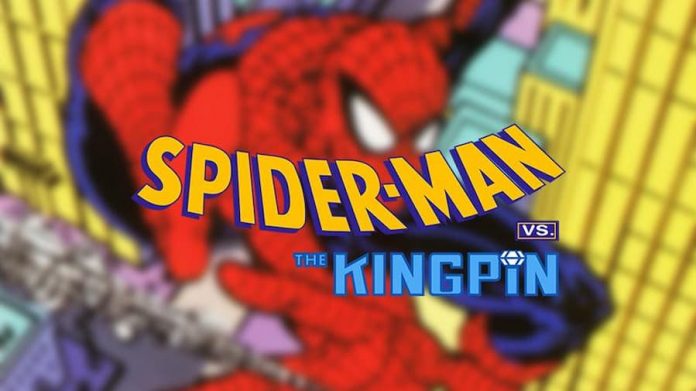
In a time when licensed games earned a bad reputation, only a certain arachnid-themed superhero can save us.
There’s a popular theorem which states that on a long enough timeline, a single monkey hitting random keys on a typewriter will eventually produce the entire works of William Shakespeare. It stands to reason, then, that a licensed character who has had innumerate video games made about them will eventually find themselves in a good one.
We’ve been spoilt rotten for Spider-Man games, with 2018’s PS4-exclusive Marvel’s Spider-Man and even going back to 2004’s Spider-Man 2. During the 8 and 16-bit eras, however, licensed games were largely and rightfully considered poor – including many of the titles based around everyone’s favourite wall-crawling superhero.
The lower quality of licensed titles during this period is largely down to two reasons. Firstly, this was a time of far smaller development budgets so getting an expensive licence meant that a publisher would invariably have to hire a less-experienced, cheaper development team to compensate. Secondly, there’s just little incentive to produce anything of worth if you can sell a title based on name branding rather than its quality.
Released in 1991 for SEGA Mega Drive (or Genesis in North America), Spider-Man Vs. The Kingpin appears to slip into the same old trappings of licenced game malaise, having been developed by Technopop (who?) and published by SEGA (ah, right). There’s a twist in this tale, however: it’s actually pretty good.

Part of Spider-Man’s appeal is his juggling of Peter Parker’s responsibilities while being a superhero, all while being unfairly maligned in the press. Technopop wisely leaned into this when developing the story, as we open with a news broadcast by the Kingpin himself accusing Spider-Man of planting a bomb somewhere in the city. This bomb is set to go off in 24 hours and so Kingpin offers a $10,000 reward for Spider-Man’s capture.
Of course, we all know Spider-Man would never do such a thing and it’s all a ruse by Kingpin, so what we have is a platforming adventure where Spider-Man has 24 hours to find the bomb, save the city and clear his name. These 24 hours are clocked by an in-game timer in the bottom right of the game screen, and over seven stages Spider-Man will have to face a number of different villains recruited by Kingpin to slow him down. It’s a decent little story that covers a lot of ground from the comics while reflecting the constant struggle that is Spider-Man’s life.

This struggle is no more apparent than in the opening stage. As soon as you start, you’re attacked by a beat cop who is clearly after that sweet, sweet reward money. After saving an old lady from a mugger – the cop does nothing to help, by the way – you’re free to enter Peter Parker’s apartment, though you’ll have to climb a building to get there. Quick experimentation (or reading the manual) will teach the player they can fire web with the A button, punch with the B button and jump with C. Jumping while firing web will make Spider-Man swing in an arc, and jumping and punching performs a stronger jump-kick move. It’s a brief little section but works perfectly for letting players adjust to Spider-Man’s moves, while still staying true to the character.
The second stage takes the action to a warehouse where cramped, narrow passages and small jumps force the player to adjust to sticking to the walls and ceiling. It can be a little tricky at first but when mastered it all makes you feel like Spider-Man, and these are all skills you will need for later on in the game. Defeat all the minor goons in the warehouse and make it to the end and Doctor Octopus will appear. Once he’s beaten, he’ll drop one of five coloured keys which can be used to defuse the bomb later on.

All the stages follow this simple formula of clearing the stage, fighting the boss and collecting their coloured key, but there’s an interesting level of variety to be found. While Electro’s stage at an electricity plant (where else?) is short, you have to make sure you don’t touch any of the metal girders when you fight him, making for a neat little challenge. At the end of the Central Park stage you might find that none of your attacks work on Sandman, so you have to retreat back to the start and use the single, conveniently-placed fire hydrant on him. If you play on the hardest difficulty, Venom will regularly reappear to give you a hard time. These elements are both novel and faithful to the source material, and help prevent Spider-Man Vs. The Kingpin from feeling like a typical run-left-to-right-and-punch platformer.
The final level, however, is just mean. You have to defuse the bomb by selecting each of the coloured keys you’ve collected and entering them, at the right time, into the bomb itself. Good news: this isn’t too much of a demanding task. Bad news: you’re also in some sort of mini ‘boss rush’ now with Spider-Man in one corner and Electro, the Lizard, Venom and Hobgoblin in the other.
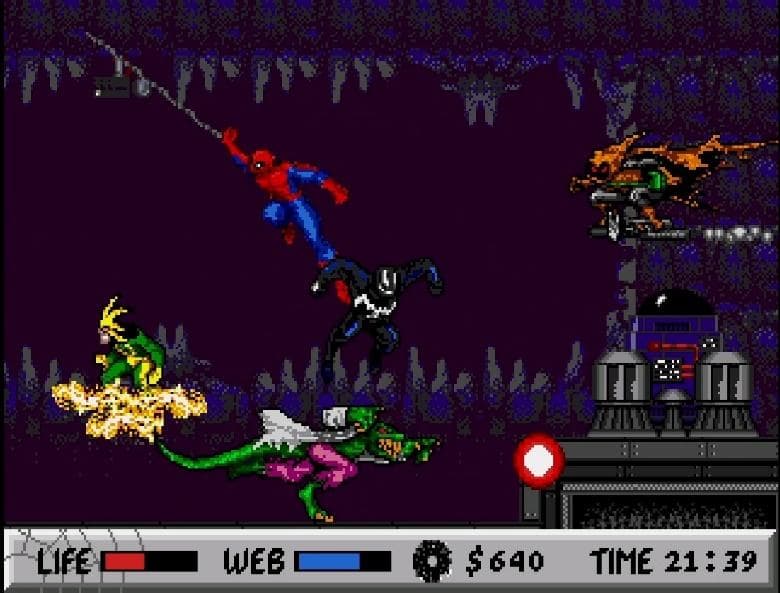
If you stay on the top level, it is possible to at least fight Electro without the other three intervening. He’s the first villain you see here and it seems Technopop wants you to think you will fight the villains again individually. But no, that’s not the case. Fall down to the ground and be prepared to be pounced on by all the villains at once. It’s a clever, if sadistic, trick by the developers and depending on how much time you have on the clock you’ll have to juggle bomb defusal with fighting the villains. While there are a few power-ups before this entire section, it’s an absolute nightmare on the harder difficulties.
A nightmare indeed, but a walk in the park compared to the final fight with the Kingpin. He’s an impressively large sprite, but his hitbox is only in his head meaning you need to have mastered the jump-kick to beat him – and you will get cheated by some dodgy collision detection. With no bomb there is no strict timer, but to add insult to injury Mary Jane has now been kidnapped and is slowly being lowered into a vat of fire. Not ideal. You’ll need to repeatedly web up the crane mechanism to prevent her demise. You can let her die and still beat Kingpin if you like – if you want the bad ending and to see Spider-Man a quivering wreck.
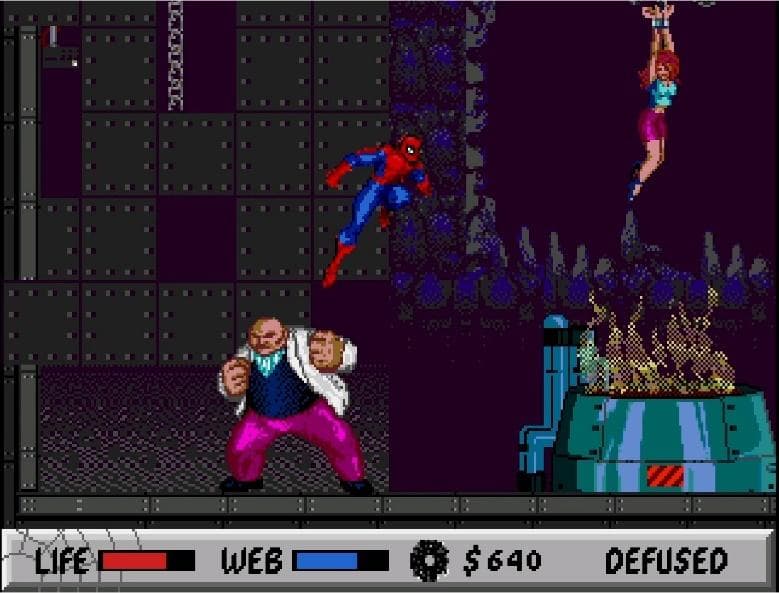
Due to the title’s high challenge, Spider-Man thankfully has a few extra abilities at his disposal. Pausing the game will bring up a menu where the A button can be reconfigured to perform one of four options. The default is, of course, Spider-Man’s standard web shot. The second option is a web shield that does a decent job of absorbing damage at the expense of using more web fluid than the standard web shot attack.
If you select the camera icon you can take photographs with the A button, and you’d do well to take photographs of every major enemy you come across. That forklift from the warehouse? Take a photo. The big gorilla in Central Park? Photo. The main villains? Snap them all. These photos can then be sold to the Daily Bugle at the end of each level and traded for more web fluid – and, given the difficulty level, that extra web fluid is going to be a godsend.
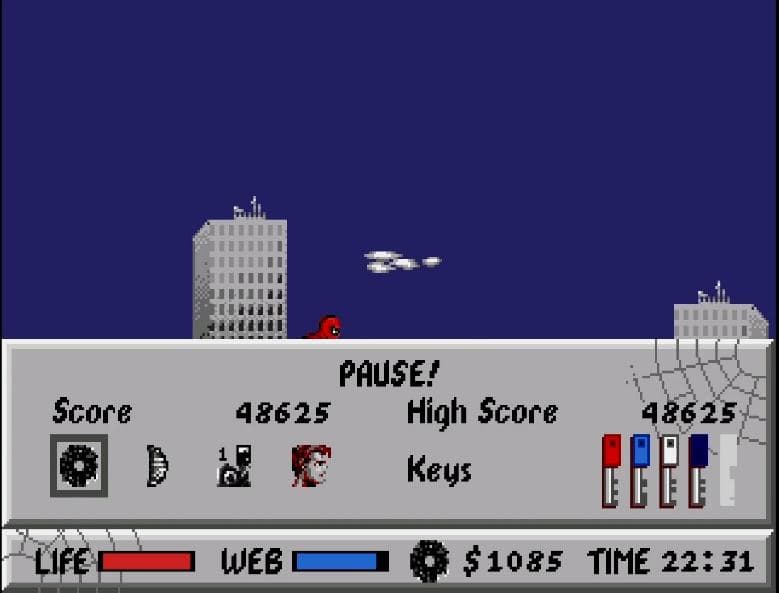
Selecting the Peter Parker head exits the level and takes you back to Peter Parker’s apartment. This allows your health to recharge, but be warned: that timer will start to tick down much faster than before and you’ll have to restart whatever level you were on when you leave. There’s a nice risk/reward in play here, which helps you conserve energy but at the expense of having to move a little quicker to beat the game. While neither of these mechanics are necessarily deep enough to call them ‘RPG-like’, they are genuinely useful and it’s important to make the most of them if you want to beat the game.
Graphics are impressive, too. Sprites are large and detailed with every character being immediately recognisable. Spider-Man’s rogues gallery offer nice colour contrast to the red-and-blue hero, such as in the green of the Lizard or the orange of the Hobgoblin, and Technopop makes sure all these colours pop with a suitably ‘comic book’ aesthetic. There’s also some good animation work going on, with Spider-Man’s movement being fluid and believable when swinging on a web or crawling on a ceiling. Though the less said about his pained expression when hit, the better.
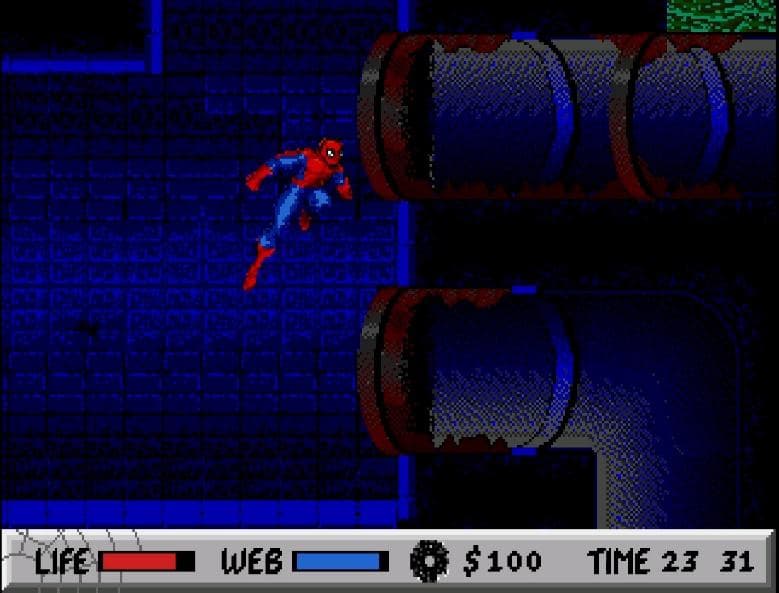
There is some noticeable dithering, with the crates and barrels of the warehouse level or the pipes of the sewer level being the most obvious examples. There also appears to be some colour-bleeding around the edges of the character, though it’s no major detraction. What is something of a detraction is the audio. Firing a web or punching sounds like punching paper and tends to grate after time, and while I quite like the musical score it is strangely downbeat for a superhero game. SEGA’s 16-bit system could – and did – do better than this back in 1991.
Nevertheless, Spider-Man Vs. The Kingpin sold so well that the developer’s own resume cites it as being picked up by two-thirds of all Genesis owners on its release, as well as saving an ailing deal between SEGA and Marvel. Also in 1991, the game was ported to the SEGA Master System and became one of the last Master System games to be released in North America. A year later, and the Game Gear saw its own port of the Master System version. In 1993, yet another version would be released for the Mega CD under the title The Amazing Spider-Man Vs. The Kingpin. This version added two new levels and the villains Mysterio and Vulture, a few new moves and the ability to collect comic book covers (something that would appear in future Spider-Man titles) but bizarrely removed the photography mechanic.
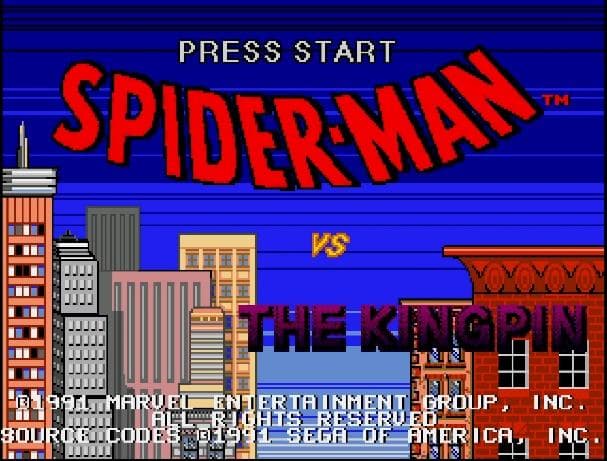
1991 proved to be a stellar year for both Sega and Marvel. The Mega Drive hit its stride with tentpole release such as Sonic the Hedgehog and Streets of Rage, and annual sales of comics reached $475 million. A deal between the two titans seemed like a natural fit. While it may not exactly be Shakespeare, Spider-Man Vs. The Kingpin proved that licenced games don’t have to be terrible at a time when licenced games really needed to not be terrible. A real boon for SEGA, it’s also a lot better than any of the Spider-Man offerings on any of Nintendo’s platforms.
As the theme song goes, “Spider-Man, Spider-Man, does whatever Nintendon’t”.

















